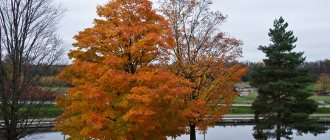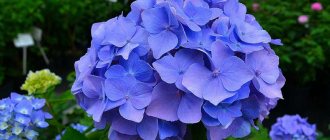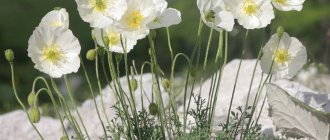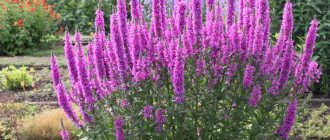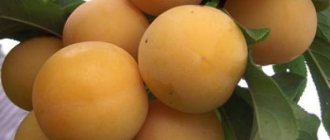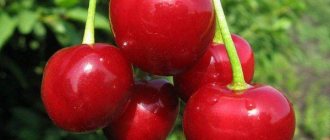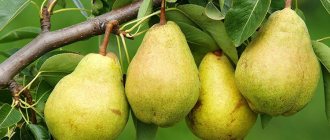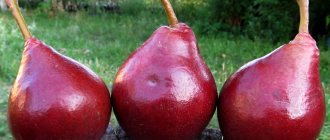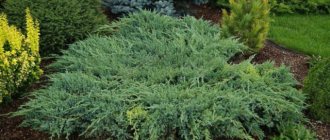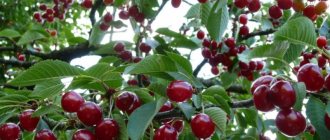03.04.2018 0
8366
Japanese maple is an amazingly beautiful plant that can fill the garden with bright colors. Depending on the variety, tree leaves have different shades. When planting an ornamental plant and during further care for it, some features should be taken into account. They will help the maple grow lush, beautiful and healthy.
Botanical description of the species
This deciduous tree or bush belongs to the perennial species of the Sappindaceae family, genus Maple. This is one of more than 150 varieties that came to our region straight from Southeast Asia, mainly its homeland is the Land of the Rising Sun and Korea. The size depends on the variety you choose, with the average maximum height attainable being 2–10 m.
Did you know? Japanese maple is included in the Red Book of Russia due to its rarity.
The leaves are small, arranged oppositely, the shape resembles a fan or palm tree, but smaller. The color varies from bright red to rich burgundy, the intensity of the shade is affected by the quality of lighting. The flowers are small, often purple-red or green-yellow, and appear mainly in April. After flowering, they turn into lionfish with seeds that are carried by the wind, and subsequently new trees grow.
Description of red maple
Maple plant is a popular genus, which includes 160 different species, for example, some of them are: American maple, bearded maple.
It grows on absolutely any soil, only swampy ones are not suitable.
This plant attracts attention with the special shade of its leaves.
Like all other plants, maple leaves contain chlorophyll.
- In summer, the color of maple is green.
- But this tree also contains anthocyanins and carotenoids. They give the leaves red, orange and unusual yellow hues.
The maple fruit is also interesting.
- Its crown is oval or round. It often resembles the shape of a porcini mushroom.
- The color of maple wood is light silver.
- It just goes perfectly with the red leaves.
- The leaves are five- or three-lobed.
Characteristics of the species
Maple with red leaves tolerates frost well. It can withstand temperature conditions down to -20 degrees inclusive.
The plant does not like constant humidity and sufficient light.
At the end of August, the tree can already be pruned, which helps rejuvenate the plant. This is allowed until December.
Attention! In the spring months, it is strictly prohibited to carry out these actions, since during this period the maple selects from the soil the nutrients necessary for normal life. Thus, it is possible that the plant will be harmed .
Vaccination is done in spring and summer through budding.
Red maple varieties
There are different types of red maple. Thus, maple, the most popular varieties, is used for landscaping parks, gardens and other public places.
"Red Sunset" is the most famous variety of wood. There is a high content of carotenoids in it. This is why the leaves of this maple tree are bright red.
Another variety, “Royal Red,” has a bright red crown color at the beginning of the growing season. Gradually the shade takes on dull outlines.
'Drummondi' - the leaves are pink when they open. After some time, the color changes to light green.
Application in landscape design
Despite its high cost, the foreign plant is widely used in landscape design. In Russia, the creation of small Japanese gardens is becoming increasingly popular. The idea is that different varieties of Japanese maples are planted along the alley, creating a natural gradation from gold to dark red. In addition, the tree goes well with ornamental plants and grasses, ponds and natural stones, and will fit well into a garden or park area.
Also read about how to use weigela shrubs in landscape design.
Due to its miniature growth, it is suitable for growing in special containers. This allows you to easily move the tree from one place to another, thereby saving it from direct sunlight or sub-zero winter temperatures. They also create bonsai from it - formed with special pruning, wire and a number of other techniques. Pots are often placed on stands to draw attention to the plant.
Japanese maple can also be placed in a home environment, as it promotes hydration and oxygen enrichment. It is a good partner for other garden plants, shrubs and cereals - its relatively weak root system does not inhibit nearby crops. Considering that rockeries, alpine and Japanese gardens, as well as green roofs have become very popular over the past decade, this magnificent tree will become the central figure in each of the listed methods of decorating free space.
Video: maple bonsai
Recommendations for planting
Planting and care must strictly comply with the growing instructions. Otherwise, you are unlikely to be able to grow a healthy and beautiful plant.
The ideal place for Japanese maple is partial shade, as the leaves can get burned under the bright rays of the sun. The soil for planting must be drained.
The Japanese plant loves slightly acidic soil filled with humus. To make it strong, the ground around it needs to be fertilized once a month in spring and summer; no fertilizing is done in winter.
In the case when the seedling is planted in fertile soil, one feeding will be enough for a whole year. If the soil is poor, then the tree needs to be fertilized a second time in the summer and only until August; after this, fertilizers cannot be applied to the soil, since the plant needs to prepare for winter.
The Japanese tree loves water very much . A young seedling must not only be watered, but also provided with a large volume of water. In summer it is watered once every seven days, in cold seasons - once a month. After finishing watering, pull out all the weeds and loosen the soil around the tree so that the soil is not too compacted. If watering is poor, the tree grows very slowly.
The method of planting a maple seedling is simple, you just need to remember some rules. To properly plant a Japanese tree, you need to prepare in advance:
- healthy seedling;
- peat and compost for fertilizing the soil.
The size of the pit should be twice the size of the roots of the seedling. Before planting the tree, carefully untangle the roots. Dip the peat and compost into the dug hole, then carefully immerse the seedling and cover it with earth on top, lightly compacting it.
Make sides around the seedling, this will retain moisture. Fill it well with water so that the root system takes root faster. In hot weather, water maple more often and abundantly. It is very important that the maple roots receive moisture in full, otherwise the leaves will have an unattractive brown color due to its lack. The tree does not like lime: if the roots come into contact with it, the maple will drop its leaves.
Spread a mulching layer of soil on top mixed with rotted leaves. This is excellent protection against weeds, and moisture will be retained well in the root circle.
Popular varieties
Red maples include several main cultivars: Shirasawa, palmate (fan) and Japanese. The remaining varieties were bred by breeders based on these three.
They amaze with their beauty and can differ radically from each other, which plays an important role in the plant that is right for you:
- Fan-shaped, or palm-shaped - the name appeared due to the special structure of the leaves, which have the shape of an open palm or a lace fan. The crown shape is spreading. June is the time when the bush turns deep scarlet. Throwing off its foliage, it does not lose any of its attractiveness due to its graceful branches. It is classified as dwarf because its height in adulthood does not exceed 2 m.
- Shirasawa maple is a rather rare species today. The height of an adult plant reaches a maximum of 1.5 m. The foliage is large, the dissection is weakly expressed. The most striking representative is considered to be Aureum, which can grow up to 4 m. The leaves are yellow-orange with a characteristic red border. It belongs to a number of winter-hardy plants, but most often grows in tub conditions.
- Japanese - distinguished by the elegance of foliage, changing color throughout the growing season (spring-autumn). There is a gradation of shades: green, yellow, orange, burgundy and the color of ripe cherry. The variety is afraid of frost, so it is more suitable for growing in a winter garden or greenhouse.
There are many hybrid forms, the most popular among growers are: Bloodgood, Nicholsonii, Aconitifolium, Mikawa Yatsubusa, Shino Buga Oka, Beni Kawa and Katsura.
Wood appearance
At this time, there are about a hundred species of Japanese maple. The huge variety of this plant will allow you to choose the type you like, ideal for your landscape design. The height of the tree ranges from two to ten meters. The leaves come in different colors: purple, green, pink, yellow, and more unusual colors can be found. For example, Chinese maple, also known as Bonsai, has blue, white, and light blue leaves.
The tree has a large, broad crown, a bit like a palm tree. This is a surprisingly beautiful tree. With its bright foliage, it lifts the mood and inspires creativity.
Unfortunately, in the northern regions growing Japanese maple outdoors will not be easy , but if you plant the tree in a large container that can be brought into the house or utility room in winter, you will have the opportunity to grow a gorgeous plant.
When purchasing a seedling, you should remember that planting and caring for it will require careful preparation. This process determines whether the tree will have the desired leaf color.
Requirements for growth conditions
The climate of Japan, where this variety grows naturally, is mild and quite humid, so it is suitable for planting in regions with warm climates. If you are from colder regions of Russia, the only way out is to grow it in a greenhouse or containers, so that in winter you can take the plant indoors. In nature, these maples grow near ponds and rivers and love humidity. Too much heat or cold does not have a positive effect on the general condition - the optimal temperature would be within +15...+25°C.
Landing
Like any incredibly beautiful tree, maple has the right to its whims, the main thing is to follow all the planting rules so that it is guaranteed to take root, which is worth talking about in more detail.
Video: planting Japanese maple
Rules and process of planting a seedling
To grow the tree described, you should follow a few simple rules: choose the right place for planting, time of year and seedlings. It is recommended to purchase planting material in a special container in order to plant it in the soil along with a lump of earth, thereby protecting the root system from possible damage. The optimal time for planting is considered to be from early spring to late autumn.
Japanese red maple is impressed by a large amount of diffused sunlight, but not direct midday light - it is advisable to plant it in the shade of a taller tree . In addition, it is worth limiting contact with drafts and strong winds, which planting coniferous plants around the entire perimeter of the garden will help to cope with. As for the soil, the shrub is relatively undemanding. An unfavorable choice would be soil with high alkalinity, constant stagnation of moisture and lack of water permeability.
Important! The distance between planting holes should be 1.5
–
3 m.
However, almost any problem can be solved:
- drainage from stones, fragments of broken brick and granite screenings is added to the soil with “standing” water;
- mullein, humus and other organic matter of your choice are added to the planting hole with poor soil;
- It is better to choose a place where humus predominates.
The planting process itself is quite simple and consists of the following steps:
- In the selected area of the garden plot, dig a hole about 30-40 cm deep, with a diameter of 2-2.5 root systems.
- Place a dense layer of drainage (5–7 cm) at the bottom, and then the soil that needs to be moistened.
- Carefully, so as not to damage the roots, remove the bush with the earthen lump from the container, gradually transferring everything into the hole.
- Sprinkle the rhizome with peat and garden soil.
- Water the seedling thoroughly and lightly spray the young leaves.
Algorithm for growing from seeds
If you decide to grow a seedling yourself, it is recommended to purchase material in specialized stores; it is advisable to avoid online sites, and especially unknown ones - this way you can protect yourself from choosing spoiled or unsuitable seeds for planting.
Important! The seedlings are transplanted to a permanent place of growth in the second year of their life, after they have become sufficiently strong.
The germination procedure is as follows:
- Immerse the seed material in water for 3–4 hours to soften the outer shell.
- Take a container at least 15 cm high and 10–15 cm wide.
- Fill the container with fertile substrate and make holes in it.
- Place one seed in each hole, deepening it 3–5 cm.
- Cover each hole with a small layer of soil, moisten it, and then place the container in a place with warm air and no direct sunlight.
- After several leaves appear, you can transplant the seedlings into separate pots.
You can place the container in a greenhouse and open it daily for ventilation for 3-5 minutes.
Planting a plant
Japanese perennial is practically not propagated by vegetative methods. But you can grow it yourself from seeds, and then plant it in your garden in spring or autumn. To get seedlings you don’t have to do anything supernatural:
- soak the seeds for a couple of hours;
- prepare a pot with approximate dimensions of 10x10 (diameter and height);
- place the seeds in fertile soil to a depth of 4-5 cm. For each specimen - a separate hole;
- sprinkle with soil, cover with film or glass;
- place in a bright place without direct sun;
- Ventilate once a day by removing the shelter;
- plant in the ground when leaves begin to appear on the seedlings.
Advice. If you don’t want to bother with seeds, buy a ready-made seedling in a container. Make sure the young maple is in good health.
The process of rooting a young tree:
Care
Growing Japanese red maple requires certain knowledge and precautions, otherwise all the painstaking work will go down the drain.
Watering and mulching
The frequency of watering directly depends on the climatic conditions of the growing region and soil moisture. On average, the procedure is carried out once every 2 days, and you should periodically check that there is enough water. On hot summer days, maple requires more abundant watering , as well as additional spraying of the leaves. With the onset of the rainy season, there is no need for additional procedures.
If you neglect care, the leaves will begin to dry out and fall off altogether, which can lead to the death of the plant. Mulching the soil is carried out twice a year - in autumn and spring by sprinkling the soil around the trunk with bark, leaf humus, garden compost or wood chips . This procedure protects the root system from drying out in summer and freezing in winter, as well as from weeds.
Trimming and shaping
Experienced plant growers do not recommend carrying out forming prunings - a young, slowly growing maple does not need them at all, its crown grows evenly. However, if you notice a few “loose” branches or want to slow down the growth, it is okay to cut them off, but nothing more.
Learn how to change the color of your hydrangea.
Mature and old trees with lost decorative properties require thinning pruning, which will make the crown look lighter and more transparent, provide optimal lighting and ventilation, and also prevent the appearance of fungal diseases.
With age, the need for a rejuvenating haircut appears, during which it is necessary to follow the rules:
- pruning of large branches is carried out during the dormant period, and small branches are removed after the leaves have blossomed, but the movement of sap has not yet begun (early spring);
- While the shoots have not grown too much, it is better to cut them off;
- large branches are cut flush with bark growths, and small ones - above a pair of buds.
The cut areas do not need to be treated with anything; they need to dry naturally.
Feeding and fertilizers
Fertilization plays an important role in the healthy development of Japanese maples. The first time the procedure is carried out in the spring , 5 months after planting in the ground, but if the tree was planted in the fall, then fertilization is carried out only next spring. Next, it is advisable to feed it once every 4 weeks until the end of the season (the first third of July).
Important! Fertilizers with a high nitrogen content are prohibited.
To do this, scatter a handful of complex fertilizers under the bush (a mixture for heather crops is suitable) or lay out a layer of mature compost 5 cm high, loosening it superficially into the soil. Given the weak frost resistance, you should not continue feeding after the specified period, otherwise you risk provoking the active growth of shoots that will simply freeze in winter.
Shelter for the winter
This culture is considered to be heat-loving, so surviving the winter is a real stress and difficult test for it. Only some species have the greatest frost resistance, and it reaches -15...-20°C. To prevent the cold from destroying the plant, it is necessary to prepare for wintering. In the second half of autumn (October-November), the tree trunk circle is mulched for the last time, and the layer should be at least 10 cm in height. Part of the trunk can be covered with spruce wood, but some use special garden fleece. In areas with a mild climate, the plant is periodically cleared of snow, since young branches may break under its weight. Fan maples are most susceptible to this.
Afraid of frost
- Japanese maple – (lat. Acer japonicum) a type of perennial woody deciduous plants. Habitat: Japan, the islands of Hokkaido, Honshu and Koshu. Also grown in southern Korea.
- In natural landscapes, the ornamental plant reaches up to 10 m in height. The smooth branches and bark of the tree are colored red-gray.
- The root system is not resistant to drought. Maple needs regular watering and sprinkling.
- Red maple has low frost resistance. A deciduous tree belongs to the category of heat-loving plants, and therefore needs shelter for the winter.
- Japanese maple looks very beautiful with fall flowers such as chrysanthemums and asters. The plant also goes well with low-growing shrubs, such as boxwood, juniper or coniferous bushes.
There are more than 150 varieties of Japanese maple.
The author of the story explains what Japanese maple is and how to properly care for it. Emphasizes that you need to plant in a sunny place:
Reproduction methods
Propagating the plant yourself is not difficult. Basically, as with any ornamental plants, two methods are used: seeds and cuttings.
Seeds
This option is the most common. The seed material must be fresh, it is collected immediately after ripening, which most often falls in October. The “harvest” is placed in a dry bag and stored in a cool place. In spring, seeds are planted in one or more containers, pre-treated with a growth stimulant.
Did you know? In total, about 20 varieties of maple are grown on the territory of the Russian Federation. Basically, they are located in the European part of the country, and are completely absent in Siberia.
Over the summer, the seedlings do not add too much growth, but it is already possible to divide them into strong and weak. The latter can be removed and destroyed, and the rest can be stored in a cool place, but at above-zero temperatures. With the arrival of spring, the material is planted in pots on a permanent basis , and when they reach a height of 30 cm, they are planted in open ground.
If you prefer growing in tubs, please note that the substrate must be rich in organic fertilizers. The main advantage of this method is that there is a 100% chance that some of the seedlings will be strong. The disadvantages include painstaking care and a lot of time.
Cuttings
The time for the procedure is early autumn. Cuttings are cut from an adult tree; their height must be at least 25 cm. Planting material with two leaves, which must be shortened by half, is kept for several hours in a growth stimulator before planting.
Planting should be done to a depth of 5 cm; it is recommended to thoroughly loosen the planting hole. The soil should be moderately moist and light; for this, drainage and mineral fertilizers are added to the hole. Most often, the mixture is prepared from leaf soil, peat and river sand in a ratio of 3:2:1.
Japanese maple: description and varieties of red maple, planting and care + photos
Amateur gardeners and landscape designers are sensitive to rare ornamental plants. The Japanese maple can become the pride of every garden. Its natural distribution range is limited to the islands of Japan, the South Korean coast and the Russian island of Kunashir. It grows more often in mountainous areas.
Growing this tree crop requires certain knowledge and precautions. How to properly plant and care for a heat-loving plant.
Description of Japanese maple
In natural landscapes - a deciduous tree or shrub up to 10 meters high. The bark and branches are colored reddish-gray and are smooth.
The leaves are like those of our maple - dissected to half the diameter into several segments (from 7 to 11), large (coverage up to 15 centimeters). Depending on the variety, the dissection of the leaves can be different, sometimes they are very feathery. The petioles on which the leaves grow, 3-5 cm long, may be pubescent.
Due to the magnificent color of the leaves, this type of maple has become so popular; the crowns of the Japanese beauty fly like red flames in the middle of the garden. Some of its species have a crimson-red foliage throughout the growing season, others change color from green to yellow and crimson.
The bright, small flowers appear earlier than the leaves in spring. From them lionfish are formed. These are seed fruits up to 3 centimeters long, with the help of which plants of this genus reproduce.
Eastern maples are grown in open ground and in special tubs.
Types and interesting varieties
Japanese maple has several subspecies, and breeders have developed amazing varieties that no one can pass by indifferently. They differ in the shape of the tree and leaves, and their demands on living conditions. There can be both tall and short specimens.
It should be noted that culturally bred varieties are much more picturesque and are found much more often than basic natural varieties. In addition to the main species described above, others are also grown.
Fan-shaped (palm-shaped)
The tree, original in shape, has a spreading crown with beautiful, carved leaves. The long-lobed leaves have a lacy outline and remain golden yellow or red throughout the season. Having shed its foliage, this plant remains a decoration of the garden, thanks to its graceful branches. It blooms red in June; many varieties have been created based on it.
Shirasawa Maple
A rare variety up to 15 meters high, there are shrubs with a low-growing outline. The leaf blade is not very dissected, large. A striking representative of this species is Aureum. This shrub grows up to 4 meters high and has a yellow-orange leaf with a border around the edge. The variety is quite winter-hardy, but they also like to cultivate it in tubs.
Aconitofolia
Gorgeous maple, almost completely dissected leaves are green in summer. In autumn the tree turns purple.
Orange Dream
Yellowish-green leaves with a red border are painted in a red-orange color. Orange Dream grows quickly and is tall.
Bloodgood
A very decorative shrub with delicate outlines of dark red leaves, almost inky in color. Even in the shade it does not lose the dark color of the foliage.
Mikawa yatsubusa
Height 1.5 meters, bush dense and squat. The leaves are needle-shaped, green in spring, scarlet in autumn.
Shaina
One and a half meters in 10 years - this is the height this tree grows. It is distinguished by a dense bushy crown, its leaves are deeply cut. When it turns blood red in color, it becomes especially attractive. Shaina is planted in containers, decorating terraces and verandas, and the halls of houses.
Kiyohime
The Japanese red maple variety reaches 1.8 meters in adulthood. Green leaves are edged with red and cut. Retains color saturation in partial shade.
Beni Kawa
The leaves are light, the original red bark.
Dissectum Garnet
The finely dissected conifer-like leaves are green in spring, becoming reddish-purple or orange-yellowish in autumn. The huge crown coverage, almost twice the height, gives the tree a very beautiful, attractive appearance. Such drooping varieties of shrubs should be placed near ponds or gazebos.
Aka shigitatsu sawa
The tree is 3 meters or so tall. This plant has peculiar pink or red dissected leaves. Loves partial shade.
Wilson's Pink Dwarf
The fan maple variety is not very winter-hardy. The height of the bush in adult form is 2.5 meters, the coverage is 1 meter less. The leaves grow on red branches and are orange in color.
Shirazz
Deeply dissected green leaves with pink or red borders give a spectacular appearance. Towards the end of the season it changes color to purple.
Where to buy seedlings, where and how to plant
You should not buy Japanese maple seeds online from unknown sellers. It is advisable to come to a nursery or store engaged in certified sales and buy a tree.
It is better to purchase a seedling in spring or autumn; you need to make sure that the bush is not damaged. It must be planted immediately.
Japanese maple varieties love diffused shade and permeable soil. There is no need to choose too alkaline soils and treat the soil with lime.
The soil should be fairly fertile or slightly acidic, and always loose.
Landing
- A hole is dug twice as large as the root system of the plant;
- Pour drainage into the hole, then humus or compost with peat;
- Moisten and straighten the roots, place the tree, sprinkle with soil and water;
- To preserve moisture, mulch the tree trunk area.
Reproduction
Produced by seeds, both in nature and under cultural conditions. Seed material must be fresh.
- Before planting, the seeds are stratified by placing them in sand (it should not be wet) and kept in a cold room all winter;
- In spring they are planted in containers with special soil; they can be treated with growth stimulants;
- In autumn, the strongest shoots are left to overwinter in a cool place in the same container, where the temperature is always above zero;
- Next spring, transplant the shoots into separate pots;
- Plant seedlings that have reached 30 centimeters in a permanent place - in open ground, a tub or a pot.
Japanese red maples can be propagated vegetatively - by grafting cuttings onto palm-shaped rootstock. This procedure often ends in failure.
Care
Domestic gardeners plant low-growing varieties of Japanese maple. If it grows in a container, it needs to be fed regularly with mineral compounds. Fertilizers for heather crops are suitable. It will also need more frequent watering.
The roots of the plant do not like stagnation of water, they can rot. Therefore, watering should be abundant but timely.
On old and dense trees it is necessary to carry out anti-aging pruning. It is done in the fall, after the leaves have fallen. Sanitary removal of broken and diseased branches is carried out every year in the spring. It is also necessary for the prevention of fungus.
Preparing for winter
In the summer you need to start preparing the maple tree for winter. Finish fertilizing, watering and loosening. In late autumn, remove all leaves from the bush, and after the first frost, spray the branches with a weak (3%) copper-containing solution.
In the northern regions of Russia, it is still safer to plant this crop in tubs and bring it into a cool room for the winter. It is also practiced to overwinter directly in pots laid on their sides in the garden, in a shallow trench.
In the middle zone, they practice covering for the winter with garden non-woven material. It’s good if the winter is snowy, then the maple can survive it stably.
Spring care
With the arrival of spring, it is necessary to awaken the tub plant so that it quickly adapts and begins to grow. To do this, after the frosts have gone, on warm days the tree is shed with a large amount of water.
Attention! Tender young leaves will inevitably get sunburned in spring. To prevent this, the potted plant is placed in partial shade or covered, just like an open ground plant, with a light covering material.
Japanese maple in landscape design
Its low growth allows it to be successfully grown in containers. The advantage of this method is that the container can be moved from one place to another, saving it from the sun or removed for the winter, and also from time to time placed in different parts of the garden.
Pots are also placed on stands to make them more visible. Need I mention that the slow-growing tree is used to create bonsai. They are formed by special cutting, using wire and other techniques.
The home location of the maple dwarf is favorable for indoor air. It moisturizes, gives oxygen and pleases with flowering.
Red maple is an excellent partner for other garden plants in the garden. It does not have a very powerful root system and does not suppress nearby crops.
Combines with shrubs, flowering and cereal crops. The garden’s exclusive appearance is given by its proximity in the autumn, when the green leaves of other trees stand next to the purple and orange caps of the “Japanese”.
Rocky Japanese-style gardens, rock gardens, rock gardens, the roof of a building, a lawn - everywhere the maple tree will be the central figure. These beauties can also be planted along walking paths.
The surrounding area and the banks of small artificial reservoirs can be decorated with a picturesque bush planted nearby.
Source: https://sornyakov.net/trees/yaponskij-klen.html
Features of growing in the Moscow region
“Japanese” can be found both in green areas of Moscow and in the Moscow region. However, in open ground they die very quickly - wintering without shelter leaves them no chance of survival. Many owners, even providing a cool winter indoors or in an unheated greenhouse, note that the color of the leaves is different - they are dark, the red tint is practically not pronounced. Even if all conditions are provided to the tree, survival is not guaranteed. Experienced gardeners recommend choosing other varieties of maple - you won’t have to tinker with them much. However, it's up to you.
Also read about how to use spruce in landscape design.
Diseases and pests
By following all the rules described above, you minimize the risk of disease.
But it also happens that omissions occur, and the health of the red “foreigner” is at risk due to the emergence of the following problems:
- Gall-forming aphids appear in entire colonies on the lower part of the leaves, and the pest can be identified by the red bubbles on the greenery. All affected shoots are cut off, and the rest of the maple is treated with a soap solution or insecticide.
- The maple leaf beetle lives up to its name: it eats all the foliage and young shoots, worsening the appearance of the plant. You can get rid of the parasite using any insecticide.
- Aleurodids, or whiteflies , are insects that gnaw on all above-ground parts of the bush. It loses its attractive decorative effect, fades and stops growing. As in the two previous cases, treatment is carried out with chemicals.
- Ashweed, or powdery mildew , is a disease characterized by an unpleasant white coating. All physical processes are suspended, the maple weakens and sheds its leaves. Treatment with an antifungal drug promotes rapid recovery.
Using all the rules and recommendations outlined, as well as putting your whole soul into the process, you can grow an incredibly beautiful red maple on your site, and it, in turn, will delight the eyes of not only the owners, but also all passers-by.
Tips for caring for wood
Care and planting are individual for each type of plant. Many of them prefer the sun, but at the same time do not like direct sultry rays. This does not apply to those trees that have double colored leaves - they prefer shade. Please keep in mind:
- Japanese maple is not afraid of drafts and strong winds. If the climatic conditions in your region are cold, then the tree must be carefully covered for the winter. The ideal material for insulating maple is soft and warm garden fleece.
- In winter, shake off snow from branches, as they may break due to the weight. Do not touch branches covered with ice crust after the winter thaw; they are easily damaged.
- When forming a maple crown, the branches need to be cut off at the beginning of growth, then only the diseased and damaged parts need to be cut off.
In the case when the crown of a tree becomes very dense and its appearance is no longer so attractive, pruning is necessary. This is done as soon as the tree sheds its leaves. This will return transparency to the crown and save the plant from fungal infection.

